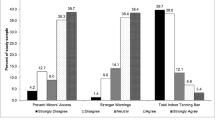Abstract
As of August 2014, 11 states in the USA have passed under-age-18 bans on indoor tanning. The Society of Behavioral Medicine, the American Academy of Dermatology, and the American Academy of Pediatrics have all issued statements in support of an under-age-18 ban. The World Health Organization and the Food and Drug Administration have both declared indoor tanning devices as carcinogenic, and this year, the Surgeon General for the first time issued a warning on the dangers of UV radiation and indoor tanning. This essay highlights how the awareness of the risks of indoor tanning, effective policies, and a conducive political atmosphere have aligned to create a window of opportunity for further under-age-18 indoor tanning legislation. The rising number of preventable skin cancers and mortalities is an issue that transcends political party lines, and now, there is a need for support from health professionals and advocates to motivate legislators to push new under-age-18 bills past their sticking points.
Similar content being viewed by others
References
Banerjee SC, Hay JL, Geller AC, Gagne JJ, Frazier AL. Quitting the “cancer tube”: a qualitative examination of the process of indoor tanning cessation. Transl Behav Med. 2014; 4(2): 209-219.
Fell GL, Robinson KC, Mao J, Woolf CJ, Fisher DE. Skin beta-endorphin mediates addiction to UV light. Cell. 2014; 157(7): 1527-1534.
National Conference of State Legislatures. Indoor Tanning Restrictions for Minors: a State-by-State Comparison. 2014; http://www.ncsl.org/research/health/indoor-tanning-restrictions.aspx. Accessed September 18, 2014.
Kingdon J. Agendas, Alternatives, and Public Policies. TBS The Book Service Ltd; 1984
Autier P. Carcinogenic to humans: why the International Agency for Research on Cancer added indoor ultraviolet (UV) tanning to group I. The Melanoma Letter. 2010;28(2)
Grewal SK, Haas AF, Pletcher MJ, Resneck JS Jr. Compliance by California tanning facilities with the nation’s first statewide ban on use before the age of 18 years. J Am Acad Dermatol. 2013; 69(6): 883-889 e884.
Mayer JE, Swetter SM, Guild S, Geller AC. The impact of indoor tanning legislation: newspaper coverage of the risks of indoor tanning before and after the California indoor tanning ban for minors. J Cancer Educ. Jun 3 2014.
Little EG, Eide MJ. Update on the current state of melanoma incidence. Dermatol Clin. 2012; 30(3): 355-361.
Acknowledgments
Thank you to Alan Geller and Samantha Guild for their invaluable guidance. This was an investigator-initiated essay that was not supported by funding of any kind. Funders played no role in the design, conduct, or analysis of the study, nor in the interpretation and reporting of the study findings. All authors, external and internal, had full access to all of the data (including statistical reports and tables) in the study and can take responsibility for the integrity of the data and the accuracy of the data analysis.
Author's statement of conflict of interest and adherence to ethical standards
Jonathan Mayer declares that he has no conflict of interest. All procedures, including the informed consent process, were conducted in accordance with the ethical standards of the responsible committee on human experimentation (institutional and national) and with the Helsinki Declaration of 1975, as revised in 2000.
Funding
This paper received no financial funding.
Author information
Authors and Affiliations
Corresponding author
Additional information
Implications
Practitioners: Using the new research data and the precedents created by the first 11 states with under-age-18 indoor tanning bans, health professionals can create the kinetic energy that motivates legislators to push new bills past their sticking points.
Policy makers: Policy makers should capitalize on the current window of opportunity to put forth and follow through on bills that protect minors from indoor tanning.
Researchers: Researchers can further study what information and tactics have been influential in the passage of recent indoor tanning legislation.
About this article
Cite this article
Mayer, J.E. The window of opportunity for indoor tanning legislation. Behav. Med. Pract. Policy Res. 4, 434–435 (2014). https://doi.org/10.1007/s13142-014-0291-y
Published:
Issue Date:
DOI: https://doi.org/10.1007/s13142-014-0291-y




